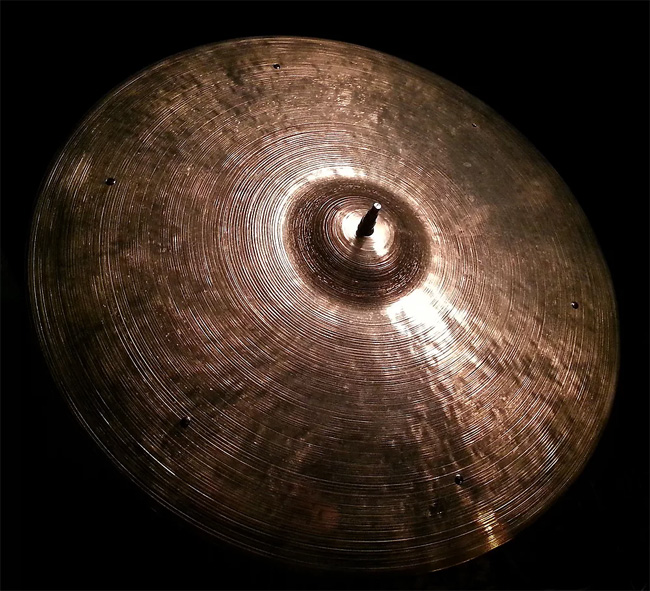When Chet Falzerano, author of Gretsch Drums: Legacy of That Great Gretsch Sound, visited Roberto Spizzichino in the last year of his life, he referred to Spizzichino as an “artisan.” But Spizzichino made a fast distinction about how he perceives himself and his work. “I am not an artisan, I am a craftsman. I do not make art, I craft sound.”
Spizzichino died in 2011, still making cymbals. Even before his passing, those “crafts” were handily fetching higher prices than the old Zildjian Ks he originally set out to recreate. In 2017, one of his rides alone is worth the same amount as a custom–made kit with a full complement of cymbals.
Roberto Spizzichino achieved a mythos equaled by only a few others in the modern world of instrument builders. When I think of Spizzichino, I think of a man who preceded him by seven centuries: Goro Nyudo Masamune, the mythic Japanese swordsmith. Bear with me: Both led hermetic lives on remote mountainsides, quietly perfecting instruments in solitary workshops that drew patrons and practitioners from around the world.
I’ll admit comparing samurai swords and cymbals is, well, nerdy. But when the cymbals can sell for north of $2,000, there’s something more to the instruments and the man behind them.
The Apprentice With No Master
Born in in Rome in January of 1944, Spizzichino spent his formative years in post–WWII Italy teaching himself jazz drums. A student of chemistry, he forewent that field in favor of music. By age 18, he made his living professionally teaching and playing drums. Granted, his knowledge of chemistry would come in handy while perfecting his secret patina process later in life.
After stints in jazz outfits throughout the ‘70s, Spizzichino’s long fixation with the sound of old Zildjian Ks led to producing his own cymbals.
If you want to make your own cymbals, you have to start from a piece of bronze and then try to understand yourself what to do."
In a short documentary made by Alex Healey, Spizzichino describes the wilderness of starting out. "I didn’t have any knowledge about how to make cymbals.... If you want to make your own cymbals, you have to start from a piece of bronze and then try to understand yourself what to do."
Working from B20 blanks, the developing master’s cymbals caught fire with the jazz community for their old–school Turkish character. His knack for hand–hammered tone earned him a spot in R&D at the Italian cymbal manufacturer UFIP where he developed company staples like the Tiger Series.

18" Spizzichino Thin Crash Ride, Sold on Reverb for $1,295
Spizzichino split from UFIP in 1986 to pursue his own vision of smithing. His handmade one–offs of this era were branded SPIZZ, but this era gets tricky with that brand name.
Spizzichino worked with the Bespeco cymbal company for a few years and sold the rights to the name SPIZZ. The manufactured cymbals didn’t meet Spizzichino’s standards, and he declined endorsement.
A similar instance happened when Wuhan made a short run of SPIZZ models in 1989. This time the cymbals were made without even the cymbalsmith’s consent, and thus are not associated with his legacy.
Today’s the SPIZZ name is still used against the family’s wishes, and the only indicator of an authentic Spizzichino cymbal is the “R. Spizzichino” stamp he personally engraved on his pieces.
Spizzichino Goes Solo
It was the period from 1991 until his death in 2011 in Pescia, Tuscany that Spizzichino perfected his legendary cymbals. Toiling alone in a workshop, Roberto hammered, lathed, and patinated thousands and thousands of blanks from Turkey and China into a select crop of masterpieces.
To really understand the quality of the cymbal, I have to use it, to know it. I have to play with it, to stay with him, with it."
The image evokes a lonesome figure surrounded by alloy. Only the latter part is true. Roberto had a wife and family and regularly welcomed guests to his one–man factory. Lithe with a crackly energy and perma–grin, a video on YouTube show him gladly bandying around his workshop, grabbing cymbals and offering them for tryouts while drummers sat at his kit.
This continued even after he was diagnosed with leukemia.

22" Spizzichino Thin Ride, Sold on Reverb for $1,895
Though he died six years ago, reverence for Roberto has yet to diminish. In an interview with our friends at Tom Tom Magazine, Heather Stine, a vanguard fusing handmade tone and boutique design, was asked who she thought was the best ever in the craft. “I have to say without a doubt that Roberto Spizzichino is the greatest.”
It’s impossible to pin down in one word what drew respect from collectors and corporations, from weekend musicians to Elvins Jones and Tony Williams. If I were to try, I’d say the cornerstone of Roberto Spizzichino’s legacy is character. The approximately 3,500 pieces he left behind are all full of the stuff. His cymbals are conversations.
In his own words, “...to really understand the quality of the cymbal, I have to use it, to know it. I have to play with it, to stay with him, with it. I say ‘him’ because [it] feels like a person. I have to ask him ‘What can I do for you to perfect you?’”
RELATED ARTICLE
Spizzichino Cymbals

